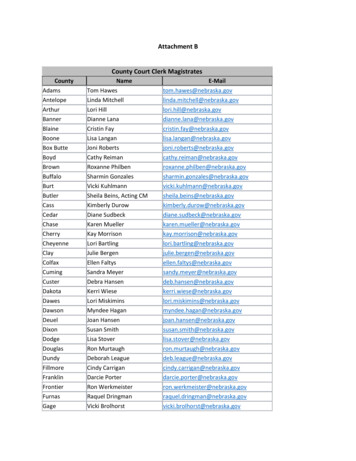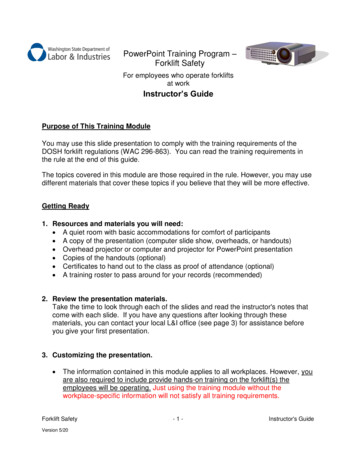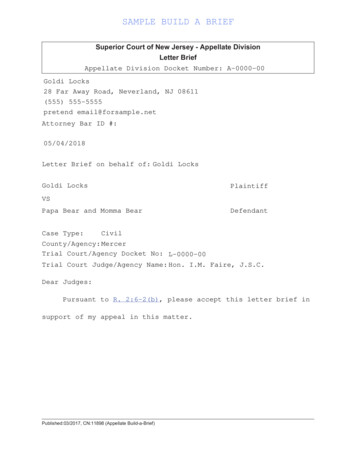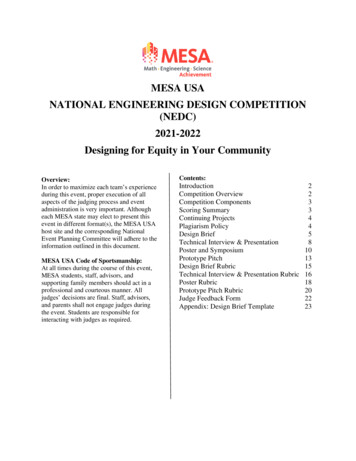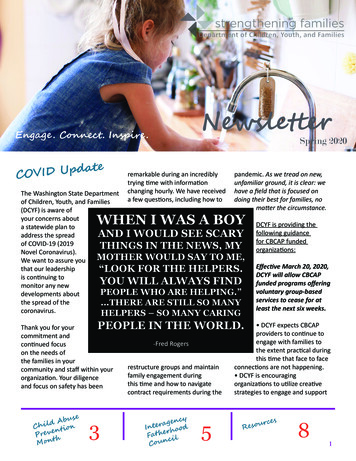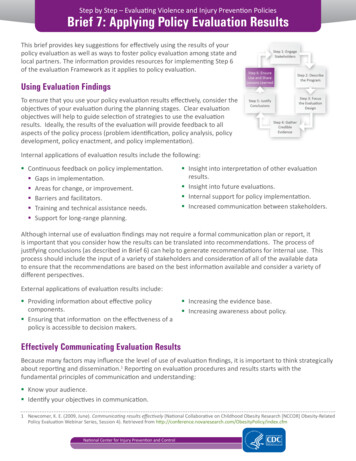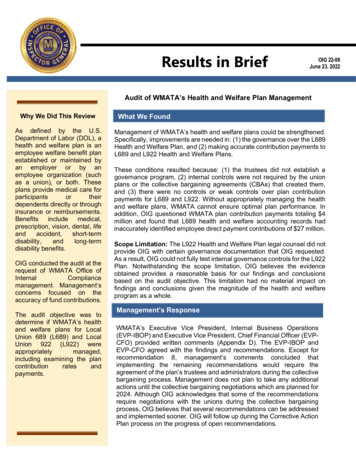
Transcription
Results in BriefOIG 22-06June 23, 2022Audit of WMATA’s Health and Welfare Plan ManagementWhy We Did This ReviewAs defined by the U.S.Department of Labor (DOL), ahealth and welfare plan is anemployee welfare benefit planestablished or maintained byan employer or by anemployee organization (suchas a union), or both. Theseplans provide medical care forparticipantsortheirdependents directly or throughinsurance or reimbursements.Benefits include medical,prescription, vision, dental, isability benefits.OIG conducted the audit at therequest of WMATA Office ofInternalCompliancemanagement. Management’sconcerns focused on theaccuracy of fund contributions.The audit objective was todetermine if WMATA’s healthand welfare plans for LocalUnion 689 (L689) and LocalUnion 922 (L922) wereappropriatelymanaged,including examining the plancontributionratesandpayments.What We FoundManagement of WMATA’s health and welfare plans could be strengthened.Specifically, improvements are needed in: (1) the governance over the L689Health and Welfare Plan, and (2) making accurate contribution payments toL689 and L922 Health and Welfare Plans.These conditions resulted because: (1) the trustees did not establish agovernance program, (2) internal controls were not required by the unionplans or the collective bargaining agreements (CBAs) that created them,and (3) there were no controls or weak controls over plan contributionpayments for L689 and L922. Without appropriately managing the healthand welfare plans, WMATA cannot ensure optimal plan performance. Inaddition, OIG questioned WMATA plan contribution payments totaling 4million and found that L689 health and welfare accounting records hadinaccurately identified employee direct payment contributions of 27 million.Scope Limitation: The L922 Health and Welfare Plan legal counsel did notprovide OIG with certain governance documentation that OIG requested.As a result, OIG could not fully test internal governance controls for the L922Plan. Notwithstanding the scope limitation, OIG believes the evidenceobtained provides a reasonable basis for our findings and conclusionsbased on the audit objective. This limitation had no material impact onfindings and conclusions given the magnitude of the health and welfareprogram as a whole.Management’s ResponseWMATA’s Executive Vice President, Internal Business Operations(EVP-IBOP) and Executive Vice President, Chief Financial Officer (EVPCFO) provided written comments (Appendix D). The EVP-IBOP andEVP-CFO agreed with the findings and recommendations. Except forrecommendation 8, management’s comments concluded thatimplementing the remaining recommendations would require theagreement of the plan’s trustees and administrators during the collectivebargaining process. Management does not plan to take any additionalactions until the collective bargaining negotiations which are planned for2024. Although OIG acknowledges that some of the recommendationsrequire negotiations with the unions during the collective bargainingprocess, OIG believes that several recommendations can be addressedand implemented sooner. OIG will follow up during the Corrective ActionPlan process on the progress of open recommendations.
Audit of WMATA’s Health and Welfare Plan ManagementOIG 22-06Table of ContentsABBREVIATIONS AND ACRONYMS . 3BACKGROUND . 4AUDIT OBJECTIVE AND RESULTS. 6FINDINGS AND RECOMMENDATIONS . 6 Finding 1 – Comprehensive Health and Welfare Governance Program Needed . 6Finding 2 – Health and Welfare Plan Benefit Contribution TransactionInconsistencies.10SUMMARY OF MANAGEMENT’S RESPONSE . .15APPENDICESA.B.C.D.Objective, Scope, and MethodologyWMATA Health and Welfare Plan Common TermsSummary of WMATA’s Health and Welfare Plan AttributesManagement’s Response-2-
Audit of WMATA’s Health and Welfare Plan ManagementOIG 22-06ABBREVIATIONS AND ACRONYMSACCTOffice of AccountingA/PAccounts PayableCBACollective Bargaining AgreementCOSOCommittee of Sponsoring Organizations of the TreadwayCommissionDOLU.S. Department of LaborEAPEmployee Assistance ProgramEIDEmployee Identification NumberERISAEmployee Retirement Income Security ActGAOU.S. Government Accountability OfficeGM/CEOGeneral Manager/Chief Executive OfficerHRHuman ResourcesL2Union Local 2L639Local 639 Teamsters (Metro Special Police)L689Local Union 689L922Local Union 922LTDLong-Term DisabilityNRPNon-Represented WMATA EmployeesSTDShort-Term DisabilityWMATAWashington Metropolitan Area Transit Authority-3-
Audit of WMATA’s Health and Welfare Plan ManagementOIG 22-06BACKGROUNDOIG conducted the audit at the request of WMATA Office of Internal Compliancemanagement. Management’s concerns focused on the accuracy of fund contributions.What is a Health and Welfare Plan?As defined by DOL, a health and welfare plan is an employee welfare benefit planestablished or maintained by an employer or by an employee organization (such as aunion), or both. These plans provide medical care for participants and/or their dependentsdirectly or through insurance or reimbursements. Benefits include medical, prescription,vision, dental, life and accident, short-term disability, and long-term disability benefits. SeeAppendix B for common terms in this area.WMATA’s Health Benefit PlansWMATA has three health benefit plans. Their descriptions are as follows: L689 Health and Welfare Plan: The Transit Employees’ Health and Welfare Plan(“L689 Health and Welfare Plan”) is a single employer plan that offers a comprehensivepackage of benefits that includes medical, prescription drug, dental, vision, life andaccident, and short-term and long-term disability insurance. The L689 Health andWelfare Plan is administered by trustees according to the terms of the CBA, thegoverning trust agreement, and applicable law. The trustees oversee the L689 Healthand Welfare Plan’s assets and make plan design recommendations and decisionsabout the benefits offered. The trustees consist of three union representatives and threeWMATA management representatives. L922 Health and Welfare Plan: The Teamsters Local 922 - Employers Health TrustPlan (“L922 Health and Welfare Plan”) is a multi-employer 1 group health plan organizedand qualified under, and governed by, the provisions of the Employee RetirementIncome Security Act of 1974 (ERISA). 2 The L922 Health and Welfare Plan is designedto assist employees and their families with medical expense payments. The L922 Healthand Welfare Plan includes medical insurance (including prescriptions), dentalinsurance, vision insurance, life insurance, long-term care insurance, and employeeassistance plan. The L922 Health and Welfare Plan is administered by a third-partycontract administrator, Carday Associates, Inc., which is now part of BeneSys, Inc. TheL922 Health and Welfare Plan is governed by trustees consisting of two unionrepresentatives and two employer representatives. The L922 Health and Welfare Planwas established as a result of collective bargaining between the union and contributingemployers. The trustees have authority to contract and manage the operation andadministration of the L922 Health and Welfare Plan. WMATA Healthcare Plan: The WMATA Healthcare Plan is a single employer selfinsured insurance and benefits plan. The Healthcare Plan is governed by trustees thatconsist of three WMATA management representatives and three union representatives.12L922 and Giant Food share health benefits in the L922 Health and Welfare Plan, thus making it a multi-employer health and welfare plan.Pub. L. 93-406, 88 Stat. 829 (codified at 29 U.S.C. 1001, et seq.)-4-
Audit of WMATA’s Health and Welfare Plan ManagementOIG 22-06The trustees have the authority to establish and amend benefit terms and contributionrequirements for management and non-represented employees. The CBAs govern thebenefit terms and contribution requirements for Transit Police, Local 639 Teamsters –Metro Special Police (L639), and Local Union 2 (L2) employees, and are the basis bywhich benefit terms and contribution requirements are established and amended.WMATA is the plan sponsor for all three of the above health and welfare plans. Althoughsome of the plan trustees are appointed by WMATA management, they are independent ofWMATA management as trustees. Each trustee has a fiduciary responsibility to the plan itserves. For a summary of the three health benefit plan duties and attributes, refer toAppendix C.WMATA’s L689 Health and Welfare Plan Contribution PaymentsFor the L689 Health and Welfare Plan, the Office of Accounting (ACCT) reviews the healthand welfare invoices and compares them to Payroll and Human Resources (HR) recordson a weekly basis. This process is intended to ensure that WMATA is billed correctly. On amonthly basis, ACCT prepares a remittance package and cover letter for the health andwelfare payment by the due date.The L689 Health and Welfare invoice is accompanied by an invoice detail report. Theinvoice detail report contains transactions for six payment streams. The payment streamsare as follows: Payroll Deduction: The employees’ share of the contribution into the L689 Health andWelfare Plan. This deduction is calculated using the annually determined rate for theemployees’ premium. Payroll Refund: Refund for employees’ share of the contribution into the L689 Healthand Welfare Plan. Matching Amount Due: WMATA’s share of the contribution into the L689 Health andWelfare Plan. It is calculated using the annually determined rate for WMATA’scontribution. Matching Amount Due Refund: Refunded amounts for the matching amount due,including any overpayment or correction to a previous billed amount. Direct Payments: Insurance premiums that are paid to the health and welfare plan bymembers who are on extended leave, leave without pay, leave of absence, disability,or receiving workers’ compensation. Once a member has paid the monthly premium tothe health and welfare plan, WMATA’s matching amount is included with the monthlypayment. The transactions are included in the detail file that accompanies the invoice. Direct Refund: A refunded amount for any overpayment.-5-
Audit of WMATA’s Health and Welfare Plan ManagementOIG 22-06WMATA’s L922 Health and Welfare Plan Contribution PaymentsFor the L922 Health and Welfare Plan, on a monthly basis, ACCT reviews L922 payroll andL922 detail reports with pre-established rates determined by the CBA and prepares theremittance package for the health and welfare plan payment by the due date.AUDIT OBJECTIVE AND RESULTSAudit ObjectiveThe audit objective was to determine if WMATA’s health and welfare plans for L689 andL922 were appropriately managed, including examining the plan contribution rates andpayments.Audit ResultsFINDINGS AND RECOMMENDATIONSFinding 1 – Comprehensive Health and Welfare Governance Program NeededContrary to requirements, the L689 Health and Welfare Plan did not have a governanceprogram that included specific internal control requirements. This occurred because (1) thetrustees did not establish a governance program, and (2) internal controls were not requiredby the union plans or the CBAs that created them. Without a comprehensive governanceprogram for L689, WMATA cannot ensure optimal health and welfare plan performance.OIG did not opine on governance for the L922 Health and Welfare Plan becausedocumentation was not provided.What is RequiredHealth and welfare plan governance refers to the system used to organize the roles andresponsibilities of all persons managing the program. In general, good governancepromotes the timely and cost-effective delivery of benefits and, at the same time, promotesthe administration of the plan in the best interests of the plan’s members and beneficiaries.According to internal control principles, promulgated by the United States GovernmentAccountability Office (GAO) 3 and the Committee of Sponsoring Organizations of theTreadway Commission (COSO), 4 management should perform the following: 3Framework: Establish the organizational structure necessary to enable the entity toplan, execute, control, and assess the organization in achieving its objectives.GAO, Standards for Internal Control in the Federal Government, GAO-14-704G (September 2014), known as the “Green Book” nal Control — Integrated Framework (2013), https://www.coso.org/pages/ic.aspx.4 COSO,-6-
Audit of WMATA’s Health and Welfare Plan ManagementOIG 22-06 Risk Assessment: Assess the risks facing the entity as it seeks to achieve itsobjectives. This assessment provides the basis for developing appropriate riskresponses. Roles and Responsibilities: Establish an organizational structure,responsibility, and delegate authority to achieve the entity’s objectives. Internal Control Documentation and Communication: Develop and maintaindocumentation of its internal control system. Management should internallycommunicate the necessary quality information to achieve the entity’s objectives. Data Quality: Management should use quality information to achieve the entity’sobjectives, which include relevant data from reliable sources, and data processed intoquality information. Expectations of Competence: Establish expectations of competence for the healthand welfare plan administration employees or third-party administrator. Competence isthe qualification to carry out assigned responsibilities and requires relevant knowledge,skills, and abilities, which are gained largely from professional experience, training, andcertifications.assignAccording to health and welfare plan governance best practices, 5 which align with GAOand COSO internal control principles, plans should: Objectively evaluate existing risk, internal control systems, and framework (Frameworkand Risk Assessment). Identify individuals who have authority to make decisions on behalf of the plan (Rolesand Responsibilities). Have controls that dictate authority and document governing procedures (InternalControl Documentation and Communication). Source quality data and build strong processes to manage long-term in a conceptuallystructured manner (Data Quality). Have controls that dictate regular training for plan fiduciaries (members of the Boardand the plan administrator) on responsibilities and that reinforce plan governance anddecrease exposure to fiduciary liability. Training should be conducted on a routine basis,or whenever officers or committee members with fiduciary responsibilities havechanged (Expectations of Competence).5 U.S Department of Health and Human Services, Practical Guidance for Health Care Governing Boards on Compliance Oversight; Employee Retirement Income Security Actof 1974 (ERISA) Standards; and Talend Data Governance Guidance: thcare/.-7-
Audit of WMATA’s Health and Welfare Plan ManagementOIG 22-06What We FoundL689 Health and Welfare Plan – Governance ProgramNeither WMATA, the union, nor the plan’s trustees had implemented a comprehensivegovernance program to administer the L689 Health and Welfare Plan. Critical governance,control, and monitoring requirements were not implemented.L922 Health and Welfare Plan – Governance Program (Scope Limitation)L922 did not provide requested governance documentation or meet with OIG on itsgovernance program. The L922 Health and Welfare Plan counsel provided OIG with theTrust Agreement, Summary Plan Description, certified Financial Statements, IRS Form5500, and the fund administrator’s contract. Plan counsel declined, however, to provide anyother governance documentation requested by OIG, such as standard operatingprocedures, roles and responsibilities documents, and a risk assessment. In a December17, 2019 letter, plan counsel asserted that, under the provisions of ERISA, the L922 planis only required to provide the documents he made available, nothing more, and that ERISAexempts the plan from WMATA’s and OIG’s authorities under the WMATA Compact toobtain the governance documents that OIG requested. This refusal by plan counselresulted in a scope limitation on the audit, as OIG could not opine on the status of theinternal controls over L922’s Health and Welfare Plan program. See “Objective, Scope, andMethodology” section for details on the scope limitation in Appendix A. OIG does not agreewith L922 plan counsel’s assessment. OIG has decided to address that matter inRecommendation 5 below and during future OIG work.Why This OccurredThe following contributed to the conditions cited in the finding: Trustees Have Not Established a Governance Program: The L689 CBA Section 4,states: “Trustees have the main responsibility for the administration of the health andwelfare plan.” The Trustees had appointed a plan administrator to assist with managingthe Plan. The L689 Plan, Section 4(f) (incorporated into the CBA), also states: “Theresponsibilities and minimum qualifications of the administrator shall be as set forth inAppendix B-1.” However, Appendix B-1 was missing from the CBA and WMATAconfirmed the appendix was not part of the current CBA agreement. As a result, OIGcould not determine whether the roles and responsibilities of the plan administrator wereformally delegated by the Trustees or spelled out in detail. Internal Controls Not Required by CBA or Union Plan: The CBA and the L689’s Healthand Welfare Plan did not require WMATA and union management to establish oversightand internal controls.OIG recognizes that the health and welfare plans were created and governed by CBAsbetween WMATA and several unions. The Plans and their governance provisions are,therefore, a result of negotiations. WMATA does not have the unilateral ability to correct all-8-
Audit of WMATA’s Health and Welfare Plan ManagementOIG 22-06the governance deficiencies identified in this report. Comprehensive corrective action willalso require cooperation by the unions.Why This Is ImportantWithout a comprehensive governance program for the L689 Health and Welfare Plan,WMATA cannot ensure: Optimal health and welfare plan performance. For example, according to L689’s Plan,Section 7(b), “The Trustees shall furnish the General Manager and Local 689 Presidentwith all monthly financial reports, the annual audit of the Fund, and documents preparedby the Fund service providers regarding the Plan's financial condition and experience.”OIG confirmed that, apart from the annual reports, neither the GM/CEO nor a delegatedofficial had been receiving the reports required by this provision. Without procedures inplace to implement these or other accountability measures, WMATA has no assurancethe L689 Health and Welfare Plan has sound financial management prior to funding thePlan on a monthly basis. Fiduciary duties and procedures are being performed. This would include determiningcontribution and premium rates and continuously monitoring monthly contributionpayments for the health and welfare plans. Adequacy of information such as accurate participants listings for the health and welfareplan.RecommendationsWe recommend the GM/CEO in concert with the trustees and unions:1. Develop and implement a comprehensive L689 Health and Welfare Plan governanceprogram incorporating the stated internal control requirements.2. At the next CBA negotiations with L689, suggest adding provisions to the L689 CBAand the L689 Health and Welfare Plan agreement to establish proper governance andinternal controls with specific requirements.3. Determine if internal controls exist for the L922 governance program.4. If controls do not exist for L922, at the next CBA negotiations with L922, suggestdeveloping and implementing a governance program incorporating the stated internalcontrols and update the CBA accordingly.5. At the next CBA negotiations with L689 and L922, suggest adding provisions to theCBA agreements giving OIG the right to review any and all documents associated withthe plans.-9-
Audit of WMATA’s Health and Welfare Plan ManagementOIG 22-06Finding 2 – tionTransactionContrary to WMATA’s Accounting Manual and best practices, WMATA had contributiontransaction anomalies to L689 and L922 Health and Welfare Plans. This occurred becausethere were no controls or weak controls over contribution transactions for L689 and L922.Due to inadequate internal controls, OIG questioned 6 WMATA’s contribution paymentstotaling over 4 million. In addition, L689 health and welfare accounting records hadinaccurately identified additional contributions of more than 27 million through employeedirect payments. Health and welfare plan payments are large disbursements for WMATA,and it is crucial that these expenditures are accurate.What is RequiredL689 Monthly Contribution Payment ProcessAccording to WMATA’s Accounting Manual, the Financial Analyst of the General Ledgerbranch compiles the supporting documentation provided by L689 and calculatedcontribution amounts. The analyst then submits a request to Accounts Payable (A/P) forthe payment to the L689 Health and Welfare Plan.Supporting documentation provided by L689 includes: Employee deductions Cash directs Retiree contributions Retirees’ widows’ contributions Adjustments from previous month estimates Employer catch-up or refund Administration costs Employee contributionAccording to L689’s Health and Welfare Plan Administrator, WMATA provides the L689Plan Administrator with a “daily demographic data” listing of L689 employees eligible forthe L689’s Health and Welfare Plan through a secure system.L922 Monthly Contribution Payment ProcessAccording to the WMATA Accounting Manual, payments to the insurance carriers forsalaried non-represented employees and some represented employees from L922 arecalculated straight from payroll deductions.6 QuestionedCost is defined as “–a cost that is questioned by the auditor because of an audit finding: (1) [w]hich resulted from a violation or possible violation of a provision of alaw, regulation, contract, grant, cooperative agreement, or other agreement or document governing the use of Federal funds, including funds used to match Federal funds; (2)[w]here the costs, at the time of the audit, are not supported by adequate documentation; or (3) [w]here the costs incurred appear unreasonable and do not reflect the actions aprudent person would take in the circumstances.” OMB Circular A-133, Audits of States, Local Government and Non-Profit Organizations (June 27, 2003).- 10 -
Audit of WMATA’s Health and Welfare Plan ManagementOIG 22-06GAO Internal Control GuidanceAccording to the GAO’s internal control principles, management should design controlactivities to achieve objectives and respond to risks. Management should designappropriate types of control activities for the entity’s internal control system. Controlactivities help management fulfill responsibilities and address identified risk responses inthe internal control system. The common control activity categories include but are notlimited to (1) proper execution of transactions, and (2) appropriate documentation oftransactions and internal control.What We FoundHealth and Welfare Plan Benefit Contribution Transaction AnomaliesFrom May 19, 2012 to October 31, 2020, WMATA paid over 4 million in plancontributions for individuals who were not entitled to such contributions. In addition,L689’s weekly detail invoice reports inaccurately identified employee direct contributionsto the plan totaling over 27 million.a.Excess WMATA contributions: OIG identified that WMATA paid over 4 million inplan contributions for 3,206 employees who were either no longer an employee of WMATA,their employment could not be verified, or had returned to work for WMATA but theirentitlement to plan contributions was not validated. For these 3,206 employees, OIGconcluded that they were either deceased or terminated, or were coded as “active”employees, even though they were retired and subject to a lesser retiree contribution rate.(1) Inactive L689 Employees: OIG found that during the period of review, WMATA mademore than 3.9 million in plan contributions for 3,154 who were no longer active employeesdue to termination, retirement, or were deceased.Prior to CY 2020, WMATA’s HR records showed these individuals as either deceased,terminated, or retired for more than 3 years. OIG sampled 12 individuals to verify employeestatus. Explanations of four employees were provided, two of whom were verified asinactive and two of whom were retirees incorrectly categorized as active employees. L689was unable to provide documentation on the other eight individuals sampled. Examples ofinactive L689 employees with contribution activity are:Table 1: Examples of Inactive Employees with Contribution ActivityEmployeeActual Amount HR StatusEmployeePaid (CY 2012 –StatusCY 2020)L689 Employee 1L689 Employee 2L689 Employee 3 92,785 84,508 asedYears From Last Dateof WMATAEmployment to Yearwith Last ContributionActivity7 Years4 Years10 YearsA L689 Health and Welfare Plan official stated, “the Fund had no record of benefits beingprovided to these individuals or fell under the broad category of ‘bad data’.” Thus, the L689Health and Welfare Plan official did not provide any supporting documentation to validate- 11 -
Audit of WMATA’s Health and Welfare Plan ManagementOIG 22-06data or payments.(2) Unverified Employees: OIG found that WMATA made plan contributions for 35individuals whose employee identification numbers (EIDs) as reported in L689’s weeklydetail report could not be reconciled to WMATA’s HR records. Total plan contributionsmade for these 35 individuals totaled over 108,200.Table 2: Examples of Employees with Unreconcilable EIDsEmployeeActual AmountHR Status/EmployeePaid (CY 2012 –RecordsStatus2020)L689 Employee 10L689 Employee 11L689 Employee 12 42,341 39,393 15,209No recordsNo recordsNo recordsNo recordsNo recordsNo recordsEffective DateEmployee LeftWMATANo recordsNo recordsNo records(3) Rehired L922 Employees: WMATA made employer contributions to the L922 Healthand Welfare Plan for 17 retired employees who returned to work at WMATA. It was notvalidated that WMATA was required to provide contributions for these employees whoreturned to work. These transactions totaled 16,150. For example:Table 3: Examples of L922 Employees with Erroneous ContributionsEmployeeOriginalRe-HireHRJob TitleHire DateDateStatusL922 Employee 13L922 Employee eBus OperatorCustomerServiceAmbassadorL922 Employee 155/12/19874/7/2019ActiveBus OperatorEmployerContributionPaid inNovember 2019 950 950 950b.Inaccurate L689 invoice detail data: L689’s weekly detail invoice reportsinaccurately identified direct contributions to the health and welfare fund for 1,072individuals, totaling over 27 million.The weekly detail reports of contribution transactions included six payment streams, whichwere payroll deduction, payroll refund, direct payments from the employee, direct refund,matching amount due, and matching refund credit. 7The following are examples of three employees with the highest employee direct paymentsper the Plan’s weekly detail report:Table 4: Examples of Employees with Unverifiable Employee Direct PaymentsEmployeeTotal Amount (CY 2012-2020)*L689 Employee 4 1,522,986L689 Employee 5 960,669L689 Employee 6 947,164*The amounts reflect contribution transactions, in aggregate, from CY 2012 through CY 2020.7These contributions were based on the invoice detail transaction reports the L689 Plan Administrator provided to WMATA’s ACCT on a weekly basis.- 12 -
Audit of WMATA’s Health and Welfare Plan ManagementOIG 22-06According to L689 officials, the amounts did not seem normal because these transactionsshould have been based on annually determined rates, and the amounts were way aboveor below the normal. Moreover, a L689 official stated the irregular amounts were due to theL689 accounting system being broken. Potentially, the Plan’s contribution income could beoverstated.Why This OccurredThe following contributed to the conditions cited in the finding: No Governance Program for L689: No governance program has been established,as discussed in the first finding, which included the lack of internal controls such as:(1) monthly contribution transaction reports not aligned with the current processes,(2) an enterprise resource management system not accurate, integrated, and orreconciled with WMATA’s Human Resource Management system. 8 No WMATA Plan Contribution Payment Policy for L922: WMATA’s Office ofAccounting did not have (1) a policy on the monthly employer and employeecontributions process, and (2) criteria for retirees returning to work who are coveredunder the CBA or Medicare.Why This Is ImportantHealth and welfare plan monthly contribution payments are one of the highest paymentsWMATA disburses under their A/P transactions. It is critical that the internal controls overthese payments are effective to demonstrate that they are being appropriately managed.Due to the lack of adequate internal controls, OIG questioned costs for contributiontransactions totaling 4 million to the L689 and L922 Health and Welfare Plans. In addition,L689 health and welfare accounting records had inaccurately identified additionalcontributions of 27 million through employee direct payments.RecommendationsWe recommend the GM/CEO in concert with the trustees and unions:6. Verify contribution transactions by emplo
Benefits include medical, prescription, vision, dental, life and accident, short-term disability, and long-term disability benefits. OIG conducted the audit at the request of WMATA Office of Internal Compliance management. Management's concerns focused on the accuracy of fund contributions . The audit objective was to determine if WMATA's .

